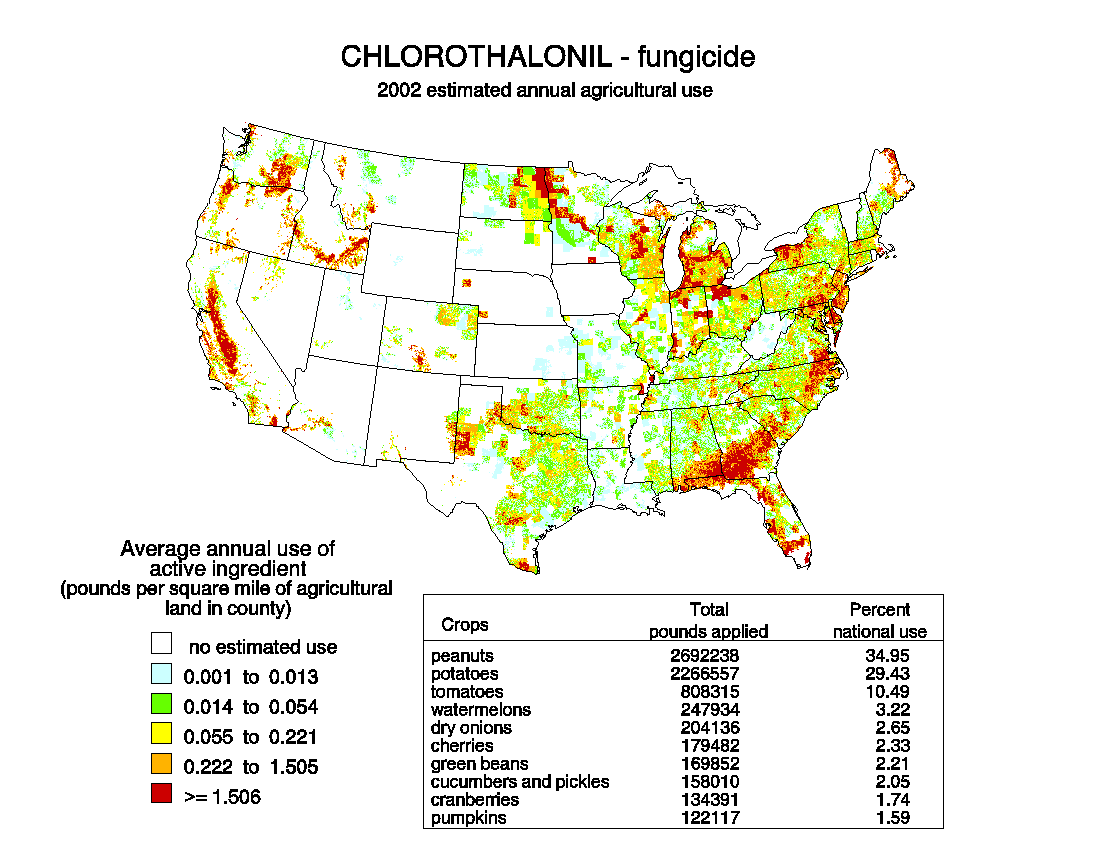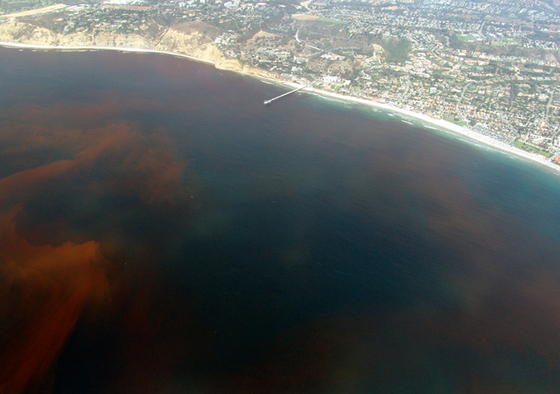Written by a friend, with additions by Brian Tomasik
First written: 2 Aug. 2012; last update: 26 Nov. 2016
Summary
Two commonly cited types of aquatic environmental degradation are pollution by fungicides (e.g., chlorothalonil) and excess plant growth (i.e., eutrophication). This paper examines the impacts of these conditions on the suffering of wild animals. Both chlorothalonil and eutrophication decrease populations of complex animals, so prima facie, they should decrease wild-animal suffering. However, it would be expected that increasing primary productivity would increase the total biomass of animals in an ecosystem. Even if chlorothalonil and eutrophication decrease the populations of large animals, it seems that other species would fill these niches. The question, then, is how much weight should be given to the sentience of invertebrates such as macroarthropods. In addition, chlorothalonil may have other negative effects, such as increased disease.
See also "How Eutrophication Affects Freshwater Invertebrate Populations".
Introduction
Many human interventions in nature have caused more mortality in higher trophic levels than in lower ones. There are several ways this can occur. For example, large predators such as wolves have been intentionally killed in the US. Another cause is biomagnification, the process in which toxins or pollutants become more concentrated in higher levels of the food chain. Finally, external stressors and unstable environments can lead to an increase in fast-reproducing r-selected species at the expense of the larger, more complex K-strategists, which tend to occupy higher levels of the food chain. Since the animals at higher levels of the food chain seem more likely to be conscious, it might appear that exterminating them would on the whole reduce wild-animal suffering. On the other hand, if this results in an increase in population at lower levels of the food chain, it is not so clear what the net effects are. The population at lower trophic levels is often orders of magnitude greater than that at higher ones, so the total suffering of lower organisms could be very great. In addition, the r-selected species at lower trophic levels have very high mortality. Of course, at some point the probability of consciousness becomes virtually zero. For example, it is almost certainly good to increase fungi life at the expense of animal life when such a tradeoff is available. Yet in most cases, the low trophic levels will have a large impact on total suffering and must be factored into environmental decisions. The following two case studies demonstrate anthropogenic change to species balance in ecosystems and discuss implications for wild-animal suffering.
Fungicides
Chlorothalonil was the third-most commonly used fungicide in the US in 1997 (Gianessi, 2000). It is a broad-spectrum agent, which means that it affects many different species. In many animals it binds to glutathione, disrupting cellular respiration (McMahon, 2012). It is toxic to shrimp, insects, and fish at the peak expected environmental concentration (EEC) of 164 micrograms per liter (Caux, 1996; Grabusky, 2004). In addition, it kills aquatic invertebrates (Litchfield, 1996), amphibians, gastropods, and zooplankton (McMahon, 2011). The physiological effects are wide-ranging and include gill damage and severe anemia in fish and immobilization of crab larvae and water fleas (Cox, 1997). Some organisms are killed relatively quickly. For example, most amphibians die within a twenty-four hour exposure (McMahon, 2011). In these cases it may decrease net suffering, mostly by preventing the existence of future generations. This is also achieved more humanely through the suppression of eggs laid and number of hatchlings per egg (Litchfield, 1996). However, in other animals it may cause suffering without death, by reducing immune function in fish and oysters, for example (Baier-Anderson, 2000; Shelley, 2009). Parasitism and chronic disease might lead to increased suffering. Still, it seems that overall chlorothalonil decreases suffering among the organisms it affects.

The indirect effects of chlorothalonil are more ambiguous. By killing herbivores, it increases the growth of algae and thus the primary productivity of the ecosystem (McMahon, 2012). It also increases dissolved oxygen and the growth of periphyton, which are important indicators of water quality (EPA, 2011). This suggests that some organisms could thrive in this environment if they are unaffected by chlorothalonil. For example, macroarthropods (insects and crayfish) did not experience significant mortality (McMahon, 2012). There is a nonzero probability that insects and other invertebrates can suffer, so it could cause net harm if they were to proliferate in the absence of competition (Tomasik, 2012).
Eutrophication
Eutrophication is another common anthropogenic disruption of aquatic ecosystems. Approximately half of all lakes in Asia, Europe, North America, and South America are eutrophic, and a quarter of African lakes are (Bates, 2007). Eutrophication results from contamination of the water with excess nutrients from agriculture and human waste disposal. This leads to blooms of cyanobacteria and algae, which can dominate the ecosystem (Verhoeven, 2006). Table 1 summarizes the effects on various organisms in the ecosystem.
| Organism | Populations tend to... |
| seagrass (Verhoeven, 2006) | decrease |
| macrophytes (Sanchez-Carillo, 2011) | decrease |
| phytoplankton (Sanchez-Carillo, 2011) | increase |
| copepods (Gagneten, 2011) | decrease |
| rotifers (Gagneten, 2011) | increase |
| crustaceans (Gagneten, 2011; Verhoeven, 2006) | decrease |
| fish (Sanchez-Carillo, 2011; Verhoeven, 2006; Gagneten, 2011) | (mixed) |
| piscivores (Sanchez-Carillo, 2011) | decrease |

Similar to chlorothalonil pollution, eutrophication tends to increase plant life and appears to decrease animal life. Zooplankton, however, are an example of how anthropogenic stressors can increase r-selection. Environmental stressors generally select for smaller species of zooplankton (Gagneten, 2011). This indicates that the population might be shifting in favor of more r-traits. (Of course, these terms are relative since all zooplankton are r-strategists.) However, the general principle holds that external causes of mortality lead to r-selection (Mueller, 1981).
Finally, if we consider the possibility that bacteria demonstrate behavior with elementary shadows of morally relevant suffering, then it's plausible that even pure bacterial decomposition of eutrophic biomass would pose an ethical issue. How big an issue depends on our weighting of bacteria and the numbers of them involved.
More total primary productivity feeding more bacteria seems bad. That said, because anaerobic respiration is much less efficient than aerobic, presumably anaerobes can't extract as much useable energy from the same quantity of primary production as aerobes can? Could this mean that the total amount of heterotrophic biological activity in anoxic eutrophic waters is actually lower than in oxic and less eutrophic waters?
Closing thoughts
Intervening in nature with the intent of reducing wild animal suffering is unacceptable to most people. However, humans are already affecting ecosystems in very significant ways, such as through pollution. When evaluating anthropogenic change to ecosystems, whether intentional or unintentional, it is important to consider the effects on organisms not harmed by the intervention. They may increase in the absence of competition. In particular, r-selected organisms thrive, implying greater animal suffering. For this reason, there may be some forms of anthropogenic environmental degradation that increase animal suffering. Preventing these changes to ecosystems may be more acceptable to the public than attempts to deliberately intervene in nature.
References
Baier-Anderson C., Anderson R.S. (2000). The effects of chlorothalonil on oyster hemocyte activation: phagocytosis, reduced pyridine nucleotides, and reactive oxygen species production. Environ Res 83(1), 72-78.
Bates, C., & DeWreede, R. (2007). Do changes in seaweed biodiversity influence associated invertebrate epifauna? Journal of Experimental Marine Biology & Ecology, 344(2), 206-214.
Caux, P., Kent, R., & Fan, G. (1996). Environmental fate and effects of chlorothalonil: A Canadian perspective. Critical Reviews in Environmental Science and Technology, 26(1), 45-93.
Cox C. (1997). Fungicide factsheet: chlorothalonil. J Pestic Reform 17:14-20.
EPA. Periphyton as Indicators. Accessed August 2, 2012.
Gagneten, A.M. Effects of Contamination by Heavy Metals and Eutrophication on Zooplankton, and Their Possible Effects on the Trophic Webs of Freshwater Aquatic Ecosystems. In Abid A. Ansari, et al. (Eds.), Eutrophication: causes, consequences, and control (211-223). New York: Springer.
Gianessi, L.P. and Marcelli, M.B. (2000). Pesticide Use in U.S. Crop Production: 1997. National Center for Food and Agricultural Policy. Accessed August 2, 2012.
Grabusky J., Martin P.A., Struger J. (2004). Pesticides in Ontario: A Critical Assessment of Potential Toxicity of Urban Use Products to Wildlife, with Consideration for Endocrine Disruption. Vol. 3, Phenoxy Herbicides, Chlorothalonil and Chlorpyrifos. Technical Report Series No. 410. Canadian Wildlife Service. Accessed August 2, 2012.
Litchfield, M.H. (1996). Chlorothalonil. United Nations Environment Programme. Accessed August 2, 2012.
McMahon, T., Halstead, N., & Johnson, S. (2011). The fungicide chlorothalonil is nonlinearly associated with corticosterone levels, immunity, and mortality in amphibians. Environmental Health Perspectives, 119(8), 1098-1103.
McMahon, T., Halstead, N., Johnson, S., Raffel, T., Romansic, J., et al. (2012). Fungicide-induced declines of freshwater biodiversity modify ecosystem functions and services. Ecol. Lett., 15(7), 714-722.
Mueller, L.D. and Ayala, F.J. (1981). Trade-off Between r-selection and K-selection in Drosophila Populations. Proc. Natl. Acad. Sci. USA., 78(2), 1303-1305.
Sanchez-Carillo, S., et al. (2011). Freshwater Wetland Eutrophication. In Abid A. Ansari, et al. (Eds.), Eutrophication: causes, consequences, and control (195-210). New York: Springer.
Shelley, L.K., Balfry, S.K., Ross, P.S., & Kennedy, C.J. (2009). Immuno-toxicological effects of a sub-chronic exposure to selected current-use pesticides in rainbow trout [Oncorhynchus mykiss). Aquat. Toxicol. 92:95-103.
Tomasik, B. (2012). Do Insects Feel Pain? Essays on Reducing Suffering. Accessed August 2, 2012.
Verhoeven, J., Arheimer, B., Yin, C., & Hefting, M. (2006). Regional and global concerns over wetlands and water quality. Trends Ecol Evol, 21(2), 96-103.